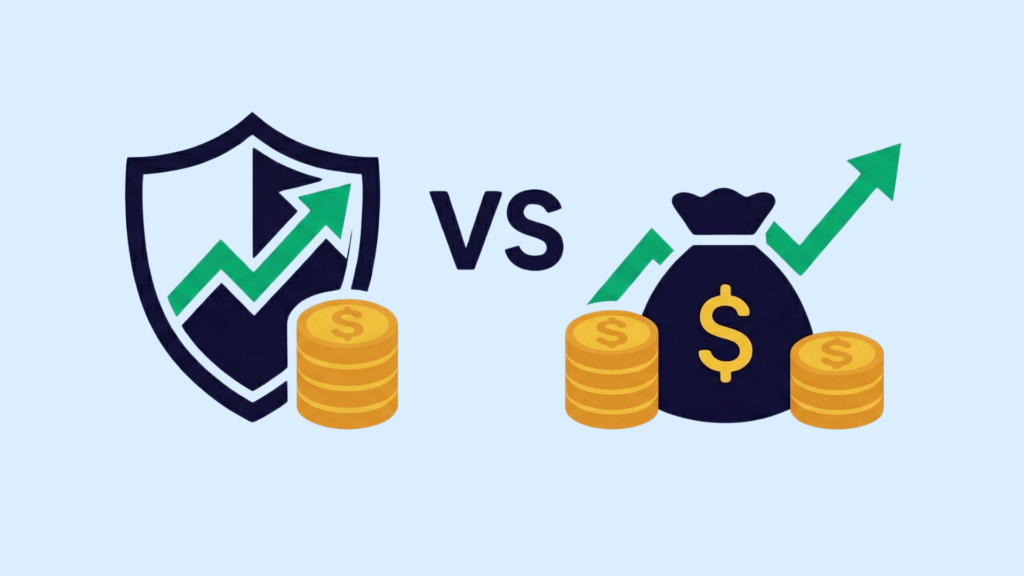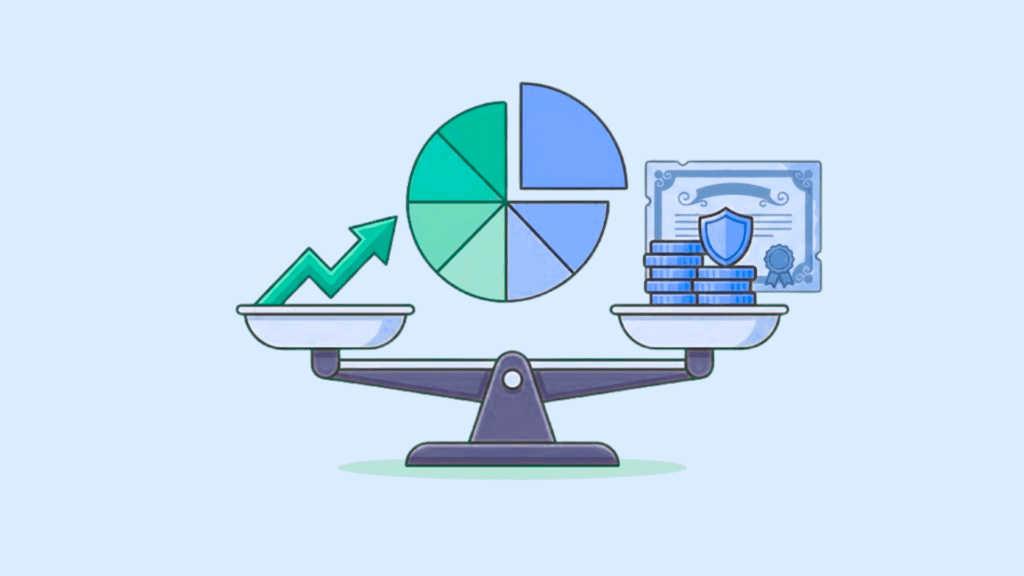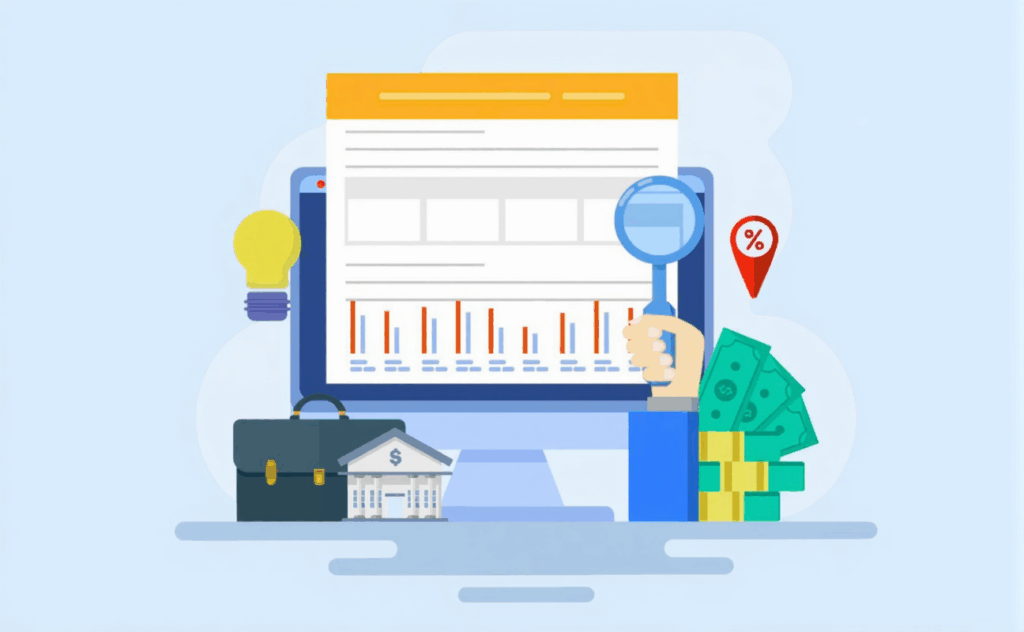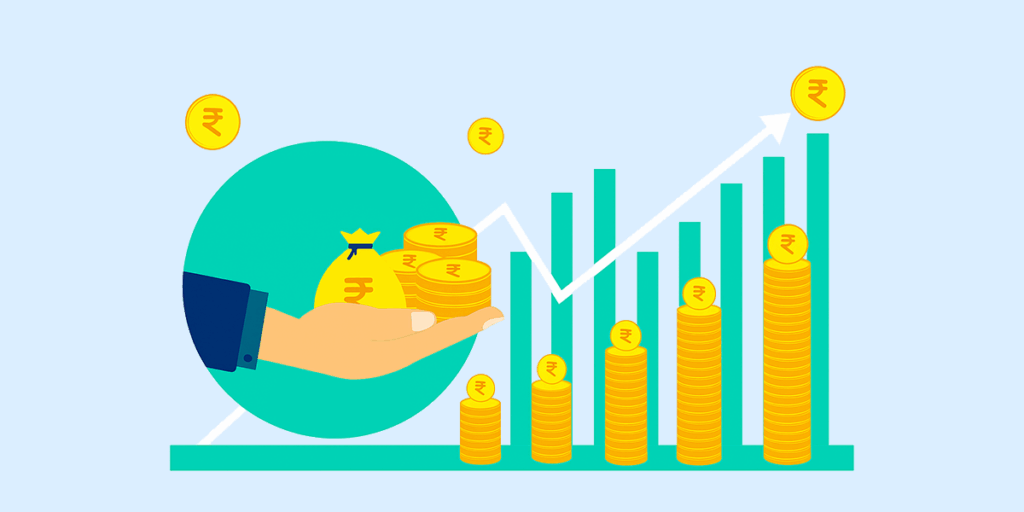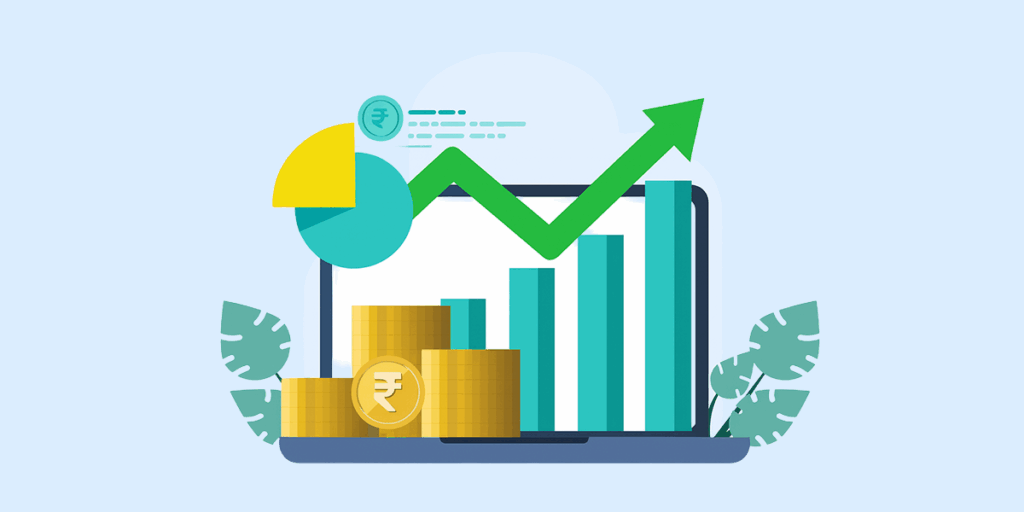Have you ever dreamed of growing your money without the hassle of picking individual stocks? Well, mutual funds are your answer. Mutual funds involve pooling your money with a group of other people to invest in a basket of stocks, bonds, or other securities.
But why should you consider mutual funds? For starters, mutual funds follow a diversified investment strategy—instead of investing all your funds in one investment, you spread your risk across multiple investments. It’s like having a financial safety net.
Keep reading to learn more about how to invest in mutual funds—the ways, the factors to consider, and the steps to take!
Steps to Start Investing in Mutual Funds
Mutual funds are a great way to grow your wealth over time. But before you start investing, it’s important to follow a strategic approach that involves:
Step 1: Risk Profiling
First, examine your risk tolerance. How much market volatility can you handle without losing sleep? Your risk profile depends on factors like age, financial goals, and personal comfort with market fluctuations. Consider taking an online risk assessment quiz or hiring a financial consultant to assess your risk profile.
Step 2: Asset Allocation
Once you know your risk profile, it’s time to decide how to divide your money among different asset classes. This typically involves a mix of equity (stocks) and debt (bonds) investments. If you’re young and have a high-risk tolerance, you might lean more towards equity. If you’re nearing retirement or prefer stability, you might favour debt.
Step 3: Identifying Suitable Funds
Now, start researching funds that match your asset allocation strategy. Look at factors like the fund’s past performance, investment objectives, and expense ratio. Also, don’t just chase high returns – consider consistency and how well the fund’s strategy aligns with your goals.
Step 4: Application Process
Once you’ve chosen your funds, it’s time to invest. You can apply online through the fund house’s website, a mutual fund platform or offline through a distributor. If you haven’t already, you’ll also need to complete a Know Your Customer (KYC) process, which involves submitting identity and address proofs.
Step 5: Diversification and Follow-up
Finally, when investing, remember to spread your investments across different funds and sectors to manage risk. Also, review your portfolio regularly—at least once a year.
How to Invest in Mutual Funds Online
With the rise in online platforms, investing in mutual funds has become easier than ever. You can start your investment journey from home with just a few clicks. Here are two popular ways to invest in mutual funds online:
Investing via Appreciate
Appreciate is a digital investment platform designed to make mutual fund investing accessible, convenient, and intelligent for beginners and experienced investors. Here’s what makes it stand out:
- ₹0 Subscription Fees: Start investing without any upfront costs.
- ₹1 Minimum Investment: Begin your investment journey with as little as one rupee.
- One-Click Investing: Simplify the investment process with easy, single-click transactions.
- Automated SIPs: Set up and manage systematic investment plans effortlessly.
- Global Investing: Access international markets and invest in world-renowned companies.
- Change Savings Feature: Automatically invest spare change from your daily expenses.
Creating an Account on AMC Websites
If you prefer to invest directly with fund houses, you can create an account on the AMC website. Here’s how you can do it:
- Go to the official website of your chosen Asset Management Company.
- Look for a button or link for new investors or account creation.
- Enter your name, contact information, and address as required.
- Provide your Aadhaar number and PAN for online verification.
- Create secure credentials—a username and password—for your account.
- Browse available mutual fund schemes and select your preferred fund(s).
- Specify the amount and complete the payment process.
- Review your investment details and confirm the transaction.
Understanding How Mutual Funds Work
When you invest in a mutual fund, you’re not just putting your money into a black box. There’s a complex system working behind the scenes to manage and grow your investment. So, let’s take a closer look at the key players who make mutual funds work:
Role of Asset Management Companies (AMCs)
Asset Management Companies pool money from investors like you to create and manage mutual funds. AMCs employ teams of financial experts, including fund managers, research analysts, and risk management professionals. These teams work together to make investment decisions on your behalf. Also, they analyse market trends, evaluate investment opportunities, and manage risks to help your money grow.
Fund Management
For each mutual fund, a dedicated fund manager is responsible for making the fund’s day-to-day investment decisions. They decide which securities to buy, hold, or sell based on the fund’s objectives and their analysis of market conditions.
Moreover, they collaborate with research analysts who provide in-depth information about potential investments. They also work closely with risk management teams to ensure the fund’s risk level aligns with its stated objectives.
Costs Associated with Mutual Funds
When investing in mutual funds, it’s important to understand their various associated costs. These charges can have a significant impact on your overall returns, so let’s break down the key costs you’ll encounter.
Expense Ratio
The expense ratio is an annual fee covering the fund’s operating expenses, including management, administrative, and marketing expenses. This ratio is a percentage of the fund’s average net assets.
Let’s say a fund has an expense ratio of 1%, and you’ve invested Rs. 10,000. This means that you’ll pay Rs. 100 annual fees will automatically be deducted from the fund’s assets. So you won’t see a separate charge on your statement.
One-Time Charges and Transaction Fees
Some mutual funds impose one-time charges or transaction fees on certain investments. These fees usually apply to more significant investments, typically over Rs. 10,000. The fee can range from Rs. 100 to Rs. 150 per transaction. These charges also apply to Systematic Investment Plans (SIPs) exceeding Rs. 10,000.
Exit Load and STT
Exit load is a fee when you sell or redeem your mutual fund units within a specified period after purchase. Fund houses implement this charge to discourage short-term investing and frequent trading, which can disrupt the fund’s management strategy. Typically, exit loads range from 0.25% to 4% of the redemption value, depending on how long you’ve held the units.
Stamp Duty
Since July 2020, all mutual fund transactions in India are subject to stamp duty. This one-time charge applies when you purchase new mutual fund units, regardless of the fund type or investment mode.
The stamp duty rate for purchasing mutual fund units is 0.005% of your investment amount. For instance, if you invest Rs. 100,000, you’ll pay Rs. 5 as stamp duty, making your effective investment Rs. 99,995.
Points to Consider Before Investing in Mutual Funds
While mutual funds offer multiple benefits, it’s not a decision to be taken lightly. Before you jump in, there are several crucial factors you need to consider, such as:
Setting Investment Goals
Before you invest a single rupee, take the time to define your financial objectives clearly. Ask yourself: What are you saving for? Is it a short-term goal like buying a car in the next two years or a long-term goal like retirement? Your investment goals will have a major influence on the type of mutual funds you should consider.
Choosing the Right Fund
With numerous mutual funds available, selecting the right one can feel overwhelming. However, by focusing on a few key factors, you can effectively narrow down your options.
First, consider your investment objective – do you want capital appreciation, steady income, or a balance of both? This will help you decide between equity, debt, or hybrid funds.
Next, assess your risk appetite. You might lean towards equity funds if you’re comfortable with more risk for potentially better returns. If stability is your priority, debt funds might be more suitable.
Risk Factors
Generally, better potential returns come with higher risk. While this principle applies to all investments, it’s particularly important in mutual funds due to their diverse nature. Equity funds, for instance, offer the potential for high returns but come with significant market risk.
However, don’t let these risks deter you. Instead, use this knowledge to make informed decisions. Diversification across different types of funds can help manage risk.
Types of Mutual Funds
Navigating the fundamentals of mutual funds can be overwhelming, but understanding the different types of funds is important for making informed investment decisions. Let’s break down the main categories of mutual funds, their characteristics, and how they might fit into your investment strategy.
Equity Funds
Equity funds primarily invest in stocks, which makes them popular for investors seeking long-term growth. These funds come in various flavours, each with its risk-return profile:
- Large-cap funds focus on established, stable companies, offering relatively lower risk but potentially slower growth.
- Mid-cap and small-cap funds target smaller companies with higher growth potential but also have more risk.
- Sectoral or thematic funds allow you to invest in particular areas like technology or healthcare.
- Equity Linked Savings Schemes (ELSS) offer tax advantages under Section 80C of the Income Tax Act.
However, remember that equity funds generally carry higher risk but also have the chance for higher returns in the long run.
Some well-regarded equity funds in India include:
- Aditya Birla Sun Life PSU Equity Fund Direct-Growth
- SBI PSU Direct Growth
- Invesco India PSU
- ICICI Prudential Infrastructure Fund Direct Plan-Growth
- Motilal Oswal Midcap Direct Growth
Debt Funds
If you want more stability in your portfolio, debt funds might be a good fit. These funds allow you to invest your money in fixed-income securities such as bonds and treasury bills. They typically offer lower risk and more consistent (though generally lower) returns than equity funds. Some types of debt funds are:
- Short-term debt funds invest in securities with shorter maturity periods, offering lower risk and returns.
- Long-term debt funds invest in securities with longer maturity periods, potentially offering higher returns but with increased interest rate risk.
- Liquid funds invest in very short-term instruments, allowing easy access to your money.
- Gilt funds invest exclusively in government securities, offering high safety but lower returns.
- Credit risk funds invest in lower-rated corporate bonds if investors are willing to take on more risk for higher yields.
Some popular debt funds in India include:
- ICICI Pru Overnight Fund
- Nippon India Nivesh Lakshya Fund
- Edelweiss Banking and PSU Debt Fund
- ICICI Pru Constant Maturity Gilt Fund
- HSBC Corporate Bond Fund
Hybrid Funds
Can’t decide between equity and debt? Hybrid funds offer a mix of both, balancing growth potential and stability. These funds come in various allocations:
- Balanced funds typically maintain a 50-50 mix of equity and debt.
- Aggressive hybrid funds lean more towards equity, while conservative hybrid funds favour debt instruments.
- Dynamic asset allocation funds adjust their equity-debt mix based on market conditions.
Plus, these funds can be a good option if you’re looking for moderate risk and returns.
Some well-known hybrid funds in India include:
- ICICI Prudential Equity & Debt Fund
- Quant Absolute Fund
- JM Aggressive Hybrid Fund
- Edelweiss Aggressive Hybrid Fund – Regular Plan
- UTI Aggressive Hybrid Fund – Regular Plan
Index Funds
If you believe in following the market rather than trying to beat it, index funds might be for you. These funds aim to copy a particular index’s performance, such as the Nifty 50.
Index funds are passively managed, meaning they don’t rely on fund managers to pick stocks. This typically results in lower expense ratios, making them a cost-effective investment option.
Some popular index funds in India include:
- Aditya Birla SL Nifty Midcap 150 IF – Dir Growth
- Motilal Oswal Nifty Midcap 150 Index Fund-Dir Growth
- Nippon India Nifty Midcap 150 Index Fund-Dir Growth
- UTI-Nifty200 Momentum 30 Index Fund – Direct-Growth
- Motilal Oswal Nifty Smallcap 250 Index Fund-DirGrowth
Exchange-traded funds (ETFs)
While not strictly mutual funds, ETFs are worth mentioning as they share similarities. ETFs are funds that trade on exchanges, much like individual stocks. They usually track an index or a specific commodity.
ETFs blend in the features of mutual funds and stocks, offering the diversification of a fund with the trading flexibility of a stock. Their risk and return profile is similar to that of index funds but with added liquidity and the ability to trade throughout the day.
Some popular ETFs in India include:
- Nippon India ETF Nifty PSU Bank BeES
- ICICI Prudential Nifty 200 Momentum 30 ETF
- Nippon India Nifty Auto ETF
- Kotak Nifty PSU Bank ETF
- Motilal Oswal NASDAQ 100 ETF
Key Mutual Funds Terminology All Beginners Should Know
Wow, all that information on mutual funds, but there were probably a few terms you didn’t quite understand, right? So, here is a list of the critical mutual fund terms you need to know to navigate the mutual fund landscape confidently.
Net Asset Value (NAV)
Think of NAV as the price tag on a mutual fund unit. It’s the per-unit cost of the fund, calculated by dividing the total value of all the fund’s assets by the amount of outstanding units. When you purchase or sell fund units, you’ll do so at the current NAV.
Expense Ratio
This is the annual fee for the fund’s management and operation. It’s expressed as a percentage of your investment and is deducted from your returns. A lower expense ratio means more of your money stays invested. While a small difference may seem insignificant, it can substantially impact your long-term returns.
Asset Under Management (AUM)
AUM represents the total market value of a mutual fund’s assets. It’s a good indicator of the fund’s size and popularity among investors. A larger AUM can mean better economies of scale, potentially lowering costs.
Systematic Investment Plan (SIP)
Under SIPs, you contribute a fixed amount to a mutual fund at regular intervals (which is usually monthly). It’s an excellent way to build discipline in your investment strategy and take advantage of rupee cost averaging (buying more units when prices are low and fewer when prices are high).
Entry Load and Exit Load
These are fees charged when you buy (entry load) or sell (exit load) mutual fund units. Entry loads have been abolished in India, but exit loads still exist for many funds, especially if you sell within a short period after buying. Be aware of these charges, as they can affect your overall returns.
Portfolio Turnover Ratio
This ratio shows how often a fund buys and sells its holdings within a year. A high turnover ratio indicates active trading, resulting in higher transaction costs and potentially higher taxes. A low turnover ratio suggests a buy-and-hold strategy.
Dividend Yield
For income-focused investors, dividend yield is crucial. It’s the ratio of the fund’s annual dividend payout to its NAV, expressed as a percentage. A higher dividend yield might seem attractive, but dividends aren’t guaranteed and can fluctuate.
Risk-Adjusted Return
This measure helps you understand the return on an investment and its risk. It’s a way to compare funds with different risk profiles. A higher risk-adjusted return indicates better performance for the level of risk taken.
Fund Manager
The fund manager is the person (or team) responsible for making investment decisions for the mutual fund. Their expertise, strategy, and track record can significantly impact the fund’s performance. When researching funds, pay attention to the fund manager’s experience and past performance, but remember that past success doesn’t guarantee future results.
Benchmark
A benchmark is a standard against which a fund’s performance is measured. It is typically a market index relevant to the fund’s investment strategy. For example, a large-cap equity fund might use the Nifty 50 as its benchmark.
Conclusion
When investing in mutual funds, remember that knowledge is your greatest asset. Whether you choose to invest through a user-friendly platform like Appreciate Wealth or directly through AMC websites, the key is to start with a clear idea of your financial goals and risk tolerance.
Don’t be swayed by short-term market fluctuations; mutual fund investing is most effective when approached with a long-term perspective. Also, while the potential for higher returns is attractive, always be mindful of the risks involved.
Frequently Asked Questions about Mutual Funds
What are the benefits of investing in mutual funds?
Investing in mutual funds offers diversification, professional management, and accessibility. By pooling money with other investors, you can access a broader range of securities and benefit from expert fund managers, which helps reduce individual investment risks and simplifies the investment process.
How can I choose the best mutual fund for my needs?
To choose the right mutual fund, consider your financial goals, risk tolerance, and investment horizon. Compare fund performance, fees, and management quality, and review the fund’s strategy to ensure it aligns with your investment objectives.
What is the minimum amount required to start investing in mutual funds?
The minimum investment amount for mutual funds varies by fund and provider, but it is often around INR 100 for a lump sum of INR 5,00 for SIPs. Some funds may have higher or lower minimums, so check the specific requirements of each fund you’re interested in.
How often should I review my mutual fund investments?
Review your mutual fund investments annually to ensure they align with your financial goals and risk tolerance. Periodic reviews help adjust for changes in market conditions or personal financial situations, keeping your investments on track.
Can I withdraw my money anytime from a mutual fund?
Yes, you can withdraw your money from a mutual fund anytime, though some funds may impose redemption fees or have specific terms. Before withdrawing, checking the fund’s redemption policies and potential tax implications is important.
What are the tax implications of investing in mutual funds?
Mutual fund investments can have various tax implications, such as capital gains taxes on profits and income taxes on dividends. The exact tax treatment depends on the type of mutual fund and your tax situation, so it’s advisable to consult a tax professional.
How do mutual funds compare with other investment options like stocks or bonds?
Mutual funds differ from stocks or bonds in their diversification and management structure. Stocks offer direct ownership in a company, while bonds are debt instruments. Mutual funds pool investments to diversify risk and are managed by professionals, providing a different risk-return profile than individual stocks or bonds.
What are the most common mistakes to avoid when investing in mutual funds?
Common mistakes in mutual fund investing include ignoring fees, neglecting to diversify, and making emotional decisions based on short-term market fluctuations. Understanding the fund’s fees, maintaining diversification, and sticking to your long-term investment plan is crucial.
How can I track the performance of my mutual fund investments?
Review regular statements and use online tools provided by your fund manager to track the performance of your mutual fund investments. Comparing your fund’s performance against benchmarks and similar funds can also provide insight into how well your investments are doing.
What is the difference between direct and regular mutual fund plans?
Direct mutual fund plans have lower expense ratios and no commission fees since you invest directly with the fund company. Regular plans involve intermediaries like brokers, which can result in higher costs due to their commissions, though they may offer additional services and advice.



